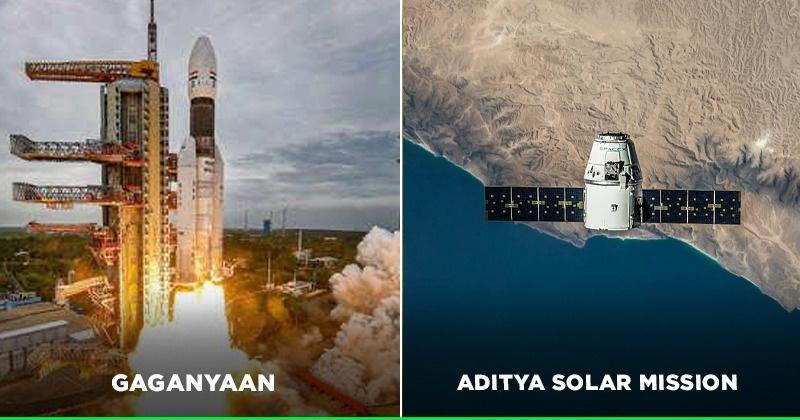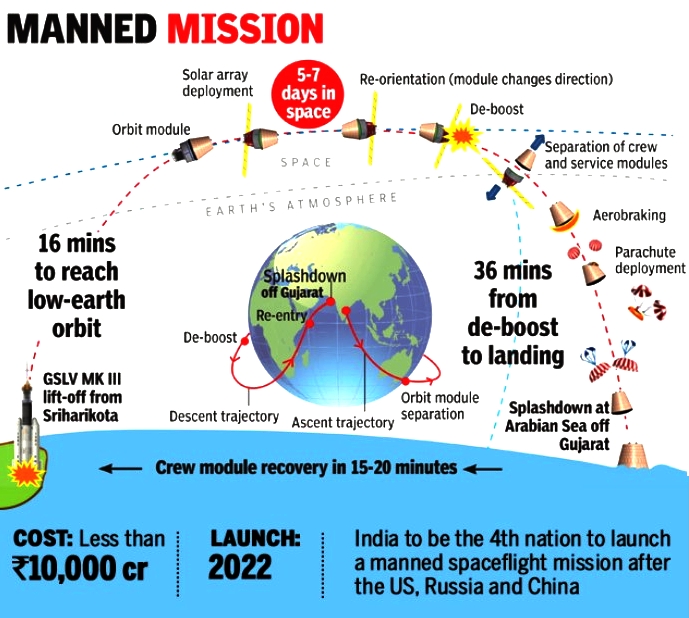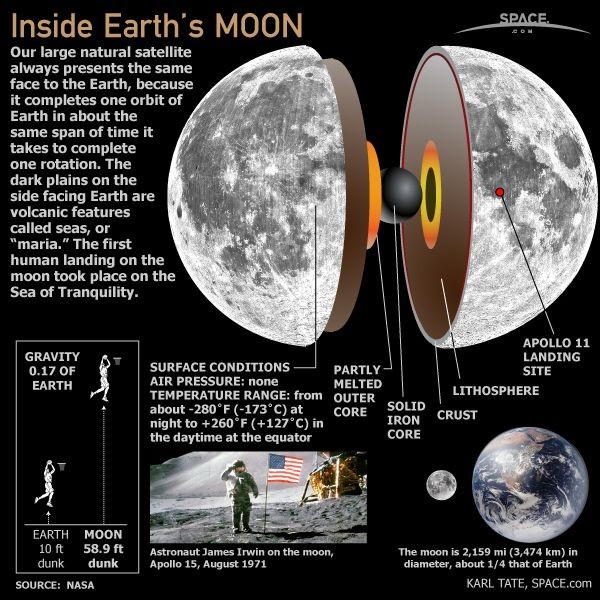Description

Disclaimer: Copyright infringement not intended.
Context
- ISRO has set new deadlines for major missions, with its first solar mission and third lunar mission set to take place in the first quarter of next year- Gaganyaan, Aditya L1, Chandrayaan 3 Missions.
Gaganyaan
About
- Gaganyaan is an Indian crewed orbital spacecraft that is intended to send 3 astronauts to space for a minimum of seven days by 2023, as part of the Indian Human Spaceflight Programme.
- The spacecraft, which is being developed by the Indian Space Research Organisation (ISRO), consists of a service module and a crew module, collectively known as the Orbital Module.
- It will be for the first time that India will launch its manned mission to space, making the country fourth in line to have sent a human to space.
Launch Vehicle
- GSLV Mk-lll (Geosynchronous Satellite Launch Vehicle) the three-stage heavy-lift launch vehicle will be used for carrying the orbital module.
- Note: This three-stage heavy lift launch vehicle, named GSLV MkIII-M1, was used for launching Chandrayaan-2.
- GSLV Mk III is designed to carry 4 ton class of satellites into Geosynchronous Transfer Orbit (GTO) or about 10 tons to Low Earth Orbit (LEO). The powerful cryogenic stage of GSLV Mk III enables it to place heavy payloads into LEO's of 600 km altitude.
- The launcher uses two S200 solid rocket boosters to provide the huge amount of thrust required for lift off.

Placement
- The spacecraft will be placed in a low earth orbit of 300-400 km.
- The human spaceflight will take 16 minutes to reach the orbit where it will stay for five to seven days.
- The capsule will rotate around the Earth every 90 minutes, and astronauts will be able to witness sunrise and sunset. The three astronauts will be able to see India from space every 24 hours, while they conduct experiments on micro-gravity.
Suit
- With the ability to hold one oxygen cylinder, the suit will allow the astronaut to breathe in space for 60 minutes.
Return
- For its return, the capsule will take 36 hours, and will land in the Arabian Sea, just off the coast of Gujarat.
Vyommitra
- ISRO has also developed a female half humanoid robot named Vyommitra, a combination of two Sanskrit words Vyoma (space) and Mitra (friend), which will be sent on the first unmanned Gaganyaan flight.
- Vyommitra will help in simulating human functions in space and will also interact with the environment control life support system.
- Vyommitra has been designed to speak in Hindi and English, can act as a companion to the astronauts, converse with them, and also respond to their queries.
Significance
- If the maiden human spaceflight Gaganyaan mission is a success, India will become the fourth country to have conducted human spaceflights after the US, Russia, and China.
- The programme would spur research and development within the country in niche science and technology
- ISRO has developed some critical technologies like re-entry mission capability, crew escape system, crew module configuration, thermal protection system, deceleration and flotation system, sub-systems of life support system required for Mission Gaganyaan.
- The human spaceflight programme will provide a unique micro-gravity platform in space for conducting experiments and a test bed for future technologies.
- It has potential for technology spinoffs in several areas such as medicine, agriculture, industrial safety, pollution, waste management, water and food resource management through this programme.
- The maiden spaceflight is also aiming to achieve economic activities such as employment generation, human resource development, and enhanced industrial capabilities.
About ADITYA L1 Mission
- The Aditya-1 mission was conceived as a 400kg class satellitecarrying one payload, the Visible Emission Line Coronagraph (VELC) and was planned to launch in a 800 km low earth orbit.
- A Satellite placed in the halo orbit around the Lagrangian point 1 (L1) of the Sun-Earth system has the major advantage of continuously viewing the Sunwithout any occultation/ eclipses.
- Therefore, the Aditya-1 mission has now been revised to “Aditya-L1 mission” and will be inserted in a halo orbit around the L1, which is 1.5 million km from the Earth.
- The satellite carries additional six payloads with enhanced science scope and objectives.
- Aditya-1 was meant to observe only the solar corona.
- The outer layers of the Sun, extending to thousands of km above the disc (photosphere) is termed as the corona.
- It has a temperature of more than a million degree Kelvin which is much higher than the solar disc temperature of around 6000K.
- How the corona gets heated to such high temperatures is still an unanswered question in solar physics.
- Aditya-L1 with additional experiments can now provide observations of Sun's Corona (soft and hard X-ray, Emission lines in the visible and NIR), Chromosphere (UV) and photosphere (broadband filters).
- In addition, particle payloads will study the particle flux emanating from the Sun and reaching the L1 orbit, and the magnetometer payload will measure the variation in magnetic field strength at the halo orbit around L1.
- These payloads have to be placed outside the interference from the Earth’s magnetic field and could not have been useful in the low earth orbit.
Chandrayaan-3
- Chandrayaan-3 is a lander-and rover-specific mission,which will demonstrate India’s capability of soft landing on a celestial body, with the rover.
- It will then communicate with Earth via the existing orbiter from Chandrayaan-2 and take images 100 km from Moon’s orbit. The orbiter has an estimated lifespan of seven years.
- The unique exploration of Chandrayaan-3 aims at studying not just one area of the Moon but all the areas combining the exosphere, the surface as well as the sub-surface in a single mission.
- With Chandrayaan-1, ISRO achieved immense success as the ‘Moon Impact Probe’ by Chandrayaan-1 lunar remote sensing orbiter detected water in vapor form in trace amounts.
- With Chandrayaan-3, India aims to further the study of the lunar surface, focussing on the South Pole or dark side of the Moon that has not seen sunlight in billions of years, which is believed to have ice and vast mineral reserves.
Why exploring the Moon is imperative?
- The Moon is the closest cosmic body at which space discovery can be attempted and documented.
- Further, Moon is a promising testbed to showcase technologies required for deep-space missions.
- Exploring the Moon will enhance our understanding of the celestial body clearly, stimulating the advancement of technology, promoting global alliances and inspiring future generations of explorers and scientists.
Why Lunar South Pole of the Moon is targeted for exploration?
- The Moon provides the best linkage to Earth’s early history and civilization.
- The exploration will offer an undisturbed historical record of the inner Solar system environment.
- The Lunar South pole is especially interesting because the lunar surface area that remains in shadow is much larger than that at the North Pole.
- Further, there could be a possibility of the presence of water in permanently shadowed areas around it.
- In addition, the South Pole region has craters that are cold traps and contain a fossil record of the early Solar System.

https://indianexpress.com/article/india/gaganyaan-abort-mission-this-yr-solar-lunar-missions-in-2023-8042227/
1.png)
















